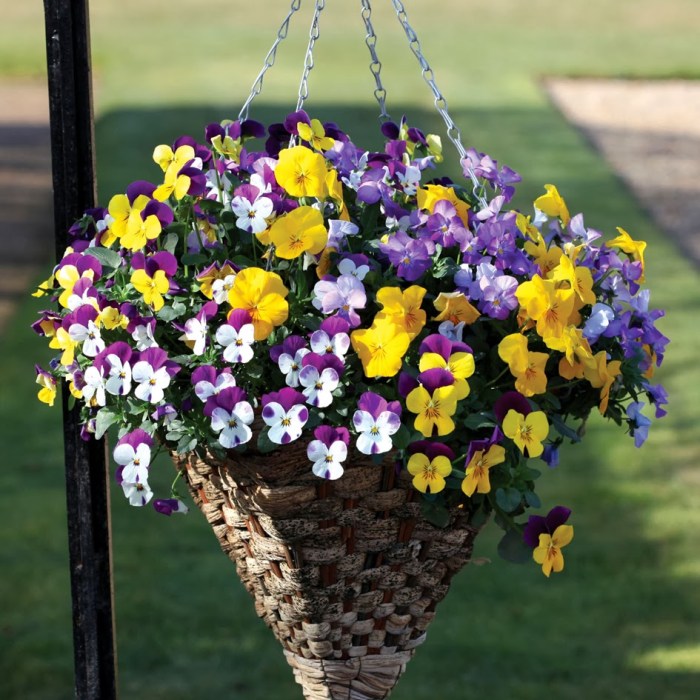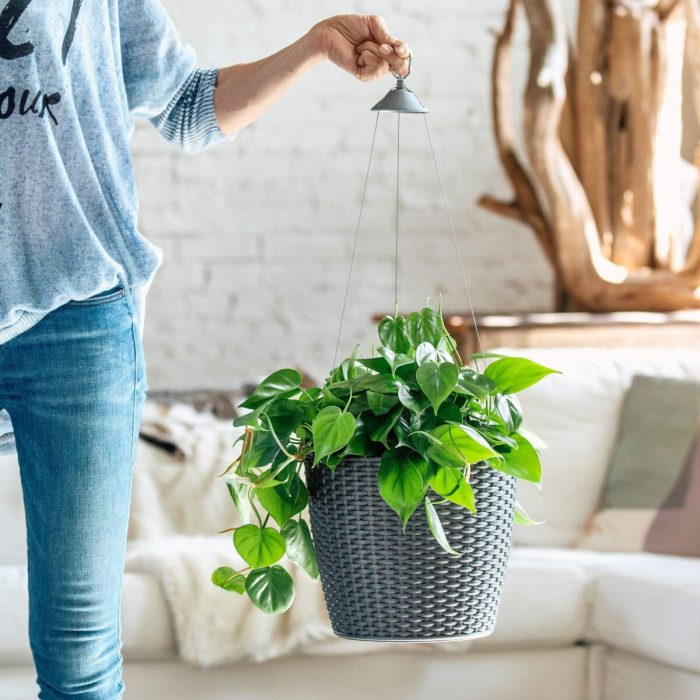When it comes to indoor and outdoor decoration, best easy hanging plants are a perfect choice for adding a touch of greenery and creating a vibrant atmosphere. These plants are not only aesthetically pleasing but also offer practical benefits, such as purifying the air and reducing stress.
In this comprehensive guide, we will delve into the world of best easy hanging plants, exploring their types, care requirements, and creative design ideas.
Popular Easy Hanging Plants
Hanging plants add a touch of greenery and elegance to any space. Whether you’re looking to brighten up a living room, add some life to a kitchen, or create a cozy corner in your bedroom, there are plenty of easy-care hanging plants that are perfect for the job.
These plants are known for their trailing growth habit, which makes them ideal for hanging baskets. They also tend to be relatively small in size, making them suitable for even the smallest spaces. And best of all, they’re all low-maintenance plants that are easy to care for, even for beginner gardeners.
Pothos
- Botanical name: Epipremnum aureum
- Common name: Pothos, Devil’s Ivy
- Pothos is one of the most popular hanging plants due to its hardiness and easy care requirements. It can tolerate a wide range of light conditions and watering schedules, making it a great choice for beginners.
Spider Plant
- Botanical name: Chlorophytum comosum
- Common name: Spider Plant
- Spider plants are known for their long, trailing leaves that produce baby spider plants at the ends. They’re also very easy to care for and can tolerate neglect, making them a great choice for busy plant parents.
String of Pearls
- Botanical name: Senecio rowleyanus
- Common name: String of Pearls
- String of pearls is a unique and eye-catching hanging plant with long, trailing stems that are covered in small, bead-like leaves. It prefers bright, indirect light and well-draining soil.
Burro’s Tail
- Botanical name: Sedum morganianum
- Common name: Burro’s Tail
- Burro’s tail is a succulent with long, trailing stems that are covered in plump, fleshy leaves. It’s a low-maintenance plant that prefers bright, indirect light and infrequent watering.
Choosing the Right Hanging Plants

When selecting hanging plants, consider the following factors:
- Sunlight availability:Choose plants that thrive in the amount of sunlight your space provides. Low-light plants, such as ferns and pothos, are ideal for dimly lit areas, while succulents and cacti prefer bright, indirect light.
- Hanging basket size:The size of the hanging basket determines the size of the plant you can accommodate. Consider the trailing length of the plant and its root system when choosing a basket.
- Desired aesthetic effect:Hanging plants can create various aesthetic effects, from lush greenery to cascading blooms. Consider the overall style of your space and the desired visual impact when selecting plants.
Matching Hanging Plants to Growing Conditions and Styles
- For low-light areas:Ferns, pothos, snake plants, and spider plants thrive in low-light conditions, making them excellent choices for dimly lit rooms or hallways.
- For bright, indirect light:Succulents, cacti, philodendrons, and hoyas prefer bright, indirect light. They are perfect for sunrooms, offices, or near windows that receive filtered sunlight.
- For lush, cascading foliage:Trailing plants like ivy, wandering Jew, and string of pearls add a touch of drama and greenery to any space. They are ideal for hanging baskets or wall-mounted planters.
- For vibrant blooms:Fuchsias, begonias, and petunias bring color and cheer to hanging baskets. They require regular watering and fertilization to maintain their blooms.
Care and Maintenance of Hanging Plants
Hanging plants bring a touch of greenery and beauty to any space, but they require proper care to thrive. Understanding their basic needs and following simple maintenance tips will ensure healthy and vibrant hanging plants.
Watering
Hanging plants generally have lower water requirements than their ground-dwelling counterparts. Overwatering is a common issue that can lead to root rot and other problems. Allow the soil to dry out slightly between waterings. Insert your finger into the soil to check for moisture; water only when the top inch or two feels dry to the touch.
Fertilizing
Fertilizing hanging plants regularly provides essential nutrients for growth and blooming. Use a balanced liquid fertilizer diluted to half strength. Fertilize during the growing season (spring and summer) every few weeks, following the instructions on the fertilizer label.
Pruning
Pruning hanging plants helps maintain their shape and encourages new growth. Regularly trim back any dead or damaged leaves and stems. You can also pinch back trailing stems to promote bushier growth. Avoid over-pruning, as it can weaken the plant.
Preventing Common Problems
- Overwatering:Yellowing leaves, wilting, and root rot are signs of overwatering. Allow the soil to dry out completely between waterings.
- Underwatering:Dry, brown leaves and stunted growth indicate underwatering. Water thoroughly and regularly, allowing excess water to drain away.
- Pests:Spider mites, aphids, and mealybugs can infest hanging plants. Use insecticidal soap or neem oil to control infestations.
Design Ideas for Hanging Plants: Best Easy Hanging Plants
Incorporating hanging plants into interior and exterior design can add a touch of greenery and create a visually appealing space. By arranging hanging plants strategically, you can enhance the overall aesthetic of your home or garden.
Vertical Gardens, Best easy hanging plants
Vertical gardens are a great way to add greenery to small spaces or create a living wall. Hanging plants can be arranged in a vertical pattern on a wall or trellis, creating a lush and eye-catching display.
Best easy hanging plants offer a perfect solution for adding greenery and enhancing indoor air quality. For those seeking to elevate their home décor and purify the air they breathe, Air Purifying Hanging Plants: Enhancing Indoor Air Quality and Aesthetics provides valuable insights and recommendations on the most effective air-purifying hanging plants.
By incorporating these plants into their homes, individuals can not only enhance the aesthetics of their living spaces but also improve their overall well-being by reducing air pollutants and promoting a healthier indoor environment.
Tiered Arrangements
Tiered arrangements involve hanging plants at different heights, creating a cascading effect. This can be achieved by using macrame hangers of varying lengths or by suspending plants from a tiered plant stand.
If you’re looking to add some greenery to your home, hanging plants are a great option. They’re easy to care for and can add a touch of elegance to any room. For a more comprehensive guide on large indoor hanging pots, click here . Some of the best easy hanging plants include pothos, spider plants, and philodendrons.
Macrame and Woven Hangers
Macrame and woven hangers are a stylish way to display hanging plants. These hangers come in a variety of designs and materials, allowing you to customize the look of your space.
For those seeking to add a touch of greenery to their homes, best easy hanging plants offer a convenient and aesthetically pleasing solution. These low-maintenance varieties thrive in suspended containers, cascading gracefully from shelves or windowsills. Explore Plants Indoor for an extensive collection of hanging plants, each boasting unique characteristics and care requirements.
Whether you prefer lush foliage or vibrant blooms, there’s a hanging plant perfect for every space.
Ceiling-Mounted Planters
Ceiling-mounted planters are a great option for high ceilings or areas where floor space is limited. These planters can be suspended from the ceiling using chains or wires, creating a dramatic focal point.
Outdoor Hanging Baskets
Hanging baskets are a classic way to add greenery to patios, balconies, and porches. They can be filled with a variety of plants, including flowers, herbs, and trailing vines.
Hanging Plant Projects

DIY hanging plant projects are a great way to add greenery to your home without taking up floor space. They’re also a fun and creative way to express your personal style.There are many different ways to create hanging plant projects, from simple macrame hangers to more elaborate planter boxes.
No matter what your skill level, there’s a project out there that’s perfect for you.
Macrame Plant Hanger
Macrame plant hangers are a popular choice for hanging plants because they’re relatively easy to make and they add a bohemian touch to any room.To make a macrame plant hanger, you’ll need:* Macrame cord
Best easy hanging plants bring a touch of greenery to any indoor space, and 8-inch hanging planters provide a versatile solution for displaying them. 8 Inch Hanging Planters: A Versatile Addition to Indoor Décor are available in a range of styles and materials, allowing you to find the perfect fit for your home’s décor.
Whether you choose a classic ceramic planter or a modern macrame design, these hanging planters will add a touch of elegance and sophistication to your space while showcasing your favorite easy-to-care-for plants.
- Scissors
- Measuring tape
- Ruler
- Beads (optional)
Instructions:
- Cut a piece of macrame cord that is four times the length of your desired hanger.
- Fold the cord in half and tie a knot at the top.
- Divide the cord into four equal strands.
- Tie a square knot with the two outer strands on each side.
- Repeat step 4 until the hanger is the desired length.
- Tie a knot at the bottom of the hanger.
- Add beads to the hanger for decoration (optional).
- Hang your plant in the hanger and enjoy!
Hanging Planter Box
Hanging planter boxes are a great way to add a touch of greenery to your patio or balcony. They’re also a great way to grow herbs or vegetables in a small space.To make a hanging planter box, you’ll need:* A wooden box
- Drill
- Screws
- Eye bolts
- Chain
- Soil
- Plants
Instructions:
- Drill four holes in the bottom of the box for drainage.
- Screw the eye bolts into the corners of the box.
- Attach the chain to the eye bolts.
- Fill the box with soil and plant your plants.
- Hang the planter box from a hook or beam.
Last Point

Whether you’re a seasoned plant enthusiast or a novice gardener, best easy hanging plants offer a versatile and rewarding way to enhance your living space. With proper care and attention, these plants will thrive and bring joy to your home for years to come.
So, let’s embark on a journey to discover the best easy hanging plants and transform your indoor and outdoor spaces into lush, green oases.
FAQ Insights
What are the most popular best easy hanging plants?
Some of the most popular best easy hanging plants include pothos, spider plants, philodendrons, ferns, and succulents.
How do I choose the right best easy hanging plants for my space?
Consider factors such as the amount of sunlight available, the size of the hanging basket, and the desired aesthetic effect when choosing best easy hanging plants.
What are the basic care requirements for best easy hanging plants?
Best easy hanging plants generally require regular watering, occasional fertilizing, and pruning to maintain their health and appearance.